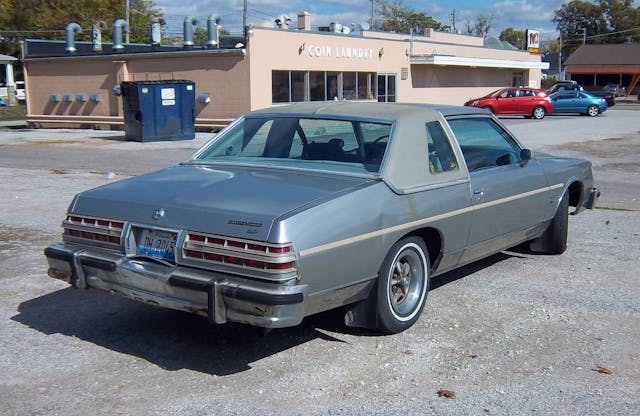1979 Bonneville Brougham and its original owner still together after all these years

Considering the dark metallic brown 1979 Bonneville sedan that my dad had when I was about three years old—it was the first car I recall ever riding in—it probably won’t come as a surprise that I am a big fan of these premium Pontiacs. While they were not nearly as popular as their Caprice, Delta 88, and LeSabre brethren, when fitted with Brougham trim and ordered with an indulgent eye on the option list, these cars could do almost everything a Coupe de Ville or Sedan de Ville could, save snob appeal. Best of all: fender skirts.
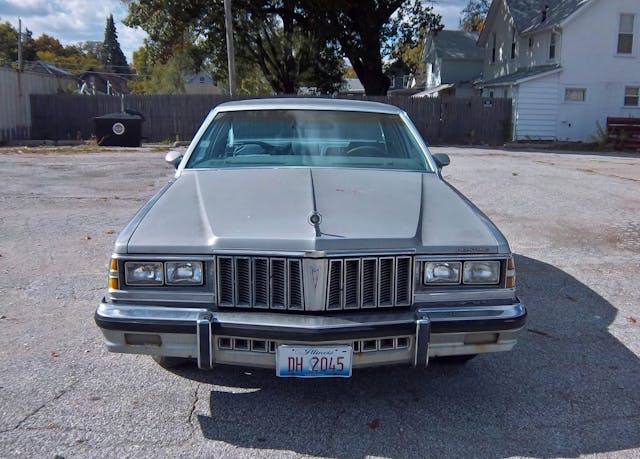
Pontiac’s full-size cars sort of floundered during the ’70s. They were perfectly serviceable as daily drivers, but had lost the ’60s style, flash, and appeal for which they’d been renowned. Exactly what was a big Pontiac supposed to be now? A cut-rate Electra 225? An extra deluxe Caprice? A plus-sized Grand Prix? Even Pontiac didn’t seem sure, and suffered for it. But things started to pick up with the downsized full-size ’77 cars.
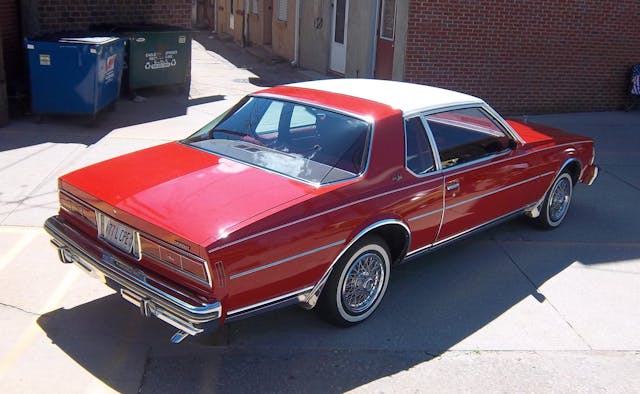
I think we all know that the 1977 General Motors B-bodies were introduced at the perfect time. Their clean, uncluttered “sheer” styling, efficient packaging, and unexpected room made for a lineup of fine family cars. Although the Chevrolets promptly blew the other divisions’ Bs out of the water, the platform’s inherent goodness helped increase the sales of all the GM full-sizers, including Pontiac’s.

By this time, the midsize segment, dominated by the Cutlass Supreme, claimed the vast majority of coupe sales. Although GM still offered full-size coupes, they were seen far less frequently than their sedan counterparts. The Bonneville (and its Canadian-kin Parisienne) was quite handsome though—perhaps so much so that by the late ’70s, the Catalina was no longer the biggest-selling full-size Pontiac. Buyers desiring a big Pontiac opted for the flossier Bonneville and Bonneville Brougham models, leaving the midsize LeMans to shoppers who just wanted a basic Pontiac sedan.

That was probably just fine with Pontiac, which certainly made a larger profit on a Bonneville over a Catalina. It was easy to distinguish the Bonnevilles, since they had a more “important”-looking grille, wider taillights, fender skirts, a gold sunburst hood ornament, and sunburst side badging on sedan C-pillars and non-Landau-roofed coupe B-pillars.
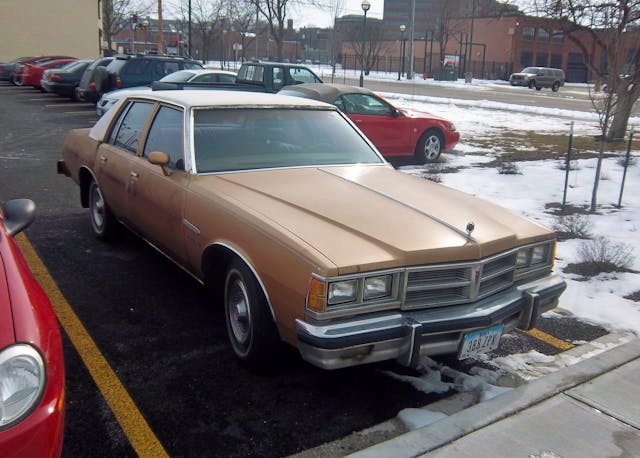
Frankly, the Catalina (and its Canadian Laurentian counterpart) was starting to look a whole lot like a fleet special that was more (recently departed) Bel Air than Impala—and even less like Catalinas of just a few years earlier. The Bonnevilles simply did “Brougham” so much better.
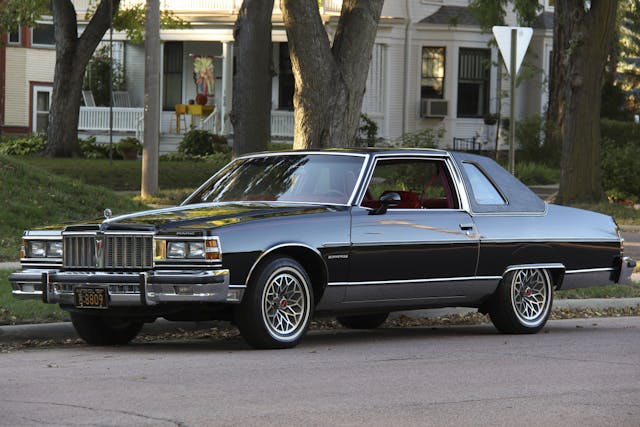
Between 1977 and ’79, Bonnevilles stayed pretty much the same, save the expected grille and taillight updates. The ’79s also lost the chrome divider between each set of rectangular headlights, which were moved closer together, and the cool snowflake alloy wheels had been moved to the option list.

I love those wheels. Of course, they’re more commonly seen on Firebirds, but I think they look excellent on Bonnevilles. Including the wagons.
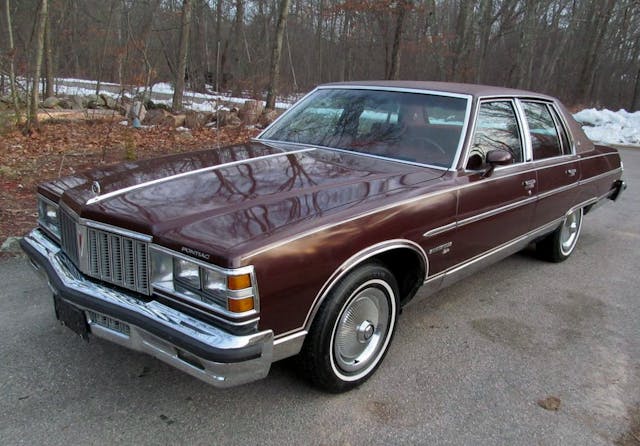
The 1977–79 big Pontiac hierarchy stayed the same as in previous years, starting with the entry-level Catalina and moving up through the Bonneville and Bonneville Brougham coupes and sedans. One model that did not return for ’79 was the Di-Noc-clad Grand Safari, which was now dubbed the Bonneville Safari.

Other than the nameplate, little was changed, right down to its wood sides. And, sadly, the wagon didn’t offer the Brougham’s loose-pillow velour seating.

And, yes, the ultra-cosseting, floating-pillow velour, split-bench seating is the very reason you’d choose the Brougham. What’s more, this was when interiors came in real colors like red, green, blue, tan, black, and white, and not just black and beige. Properly equipped, these cars could be just about as luxurious as any Cadillac.
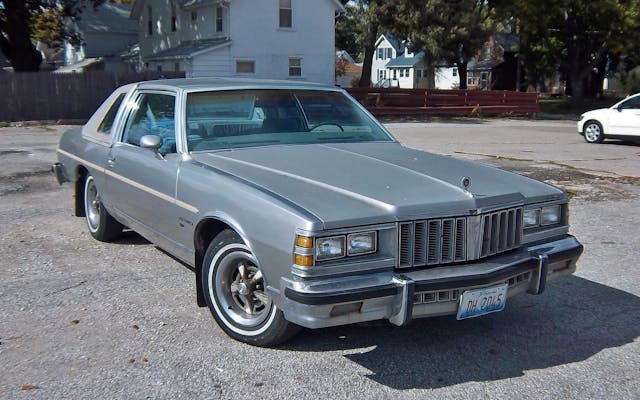
Load up your Brougham—add the snowflake alloys, whitewalls, Astroroof, and power everything—and you had an awfully nice car, all for thousands less than a Coupe or Sedan de Ville. About the only thing you couldn’t get on the Pontiac was a leather interior.
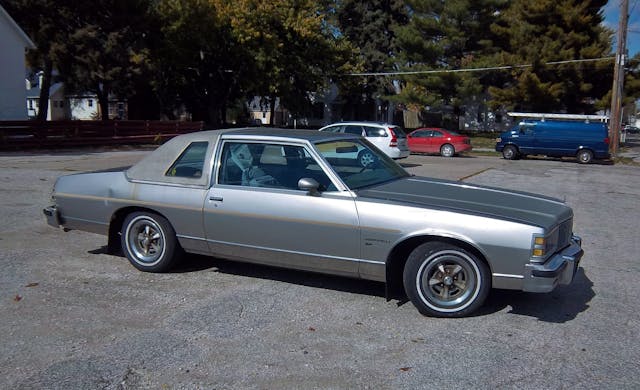
Still, many folks passed up the Bonnie in favor of the Caprice Classic, which offered essentially the same car (and luxury options) for less money.

Actually, the Pontiac occupied a sort of anti-sweet spot: It not only had a higher sticker price than the Caprice, but for just a few more dollars, Bonnie shoppers could buy a more prestigious Delta 88 Royale or LeSabre Custom. Even in the late 1970s, each GM brand retained a distinct identity that reflected one’s station in life, and buyers knew it.
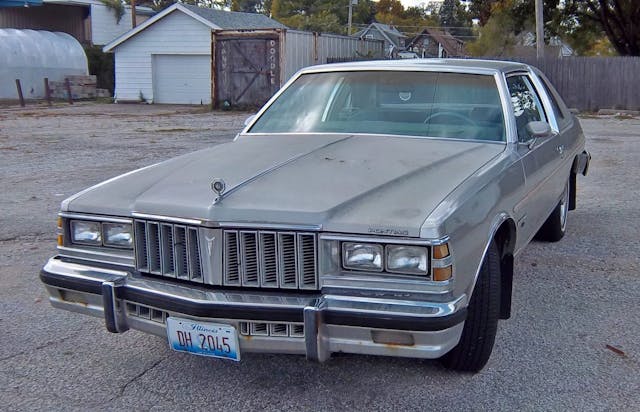
While a Bonneville Brougham cost less than a Delta 88, it was ever so much more prestigious to tell everyone at work that you got a new Oldsmobile as opposed to a new Pontiac (“A Pontiac, huh? So then it’s basically a Caprice … right, Bob?”)

Hey, under the skin, all the B-bodies were all pretty similar. But for whatever reason, Pontiac’s versions consistently owned the bottom of the B-body sales charts.

Dad’s Bonneville was the very first car I can remember, and also the first car I remember riding in as a toddler. It was almost the same as the car in the above brochure picture, but Dad’s was a ’79 and had the standard chrome wheel discs instead of the wire wheel covers. That car really made an impression on me. Why else would I have such a serious jones for them 35-odd years later?
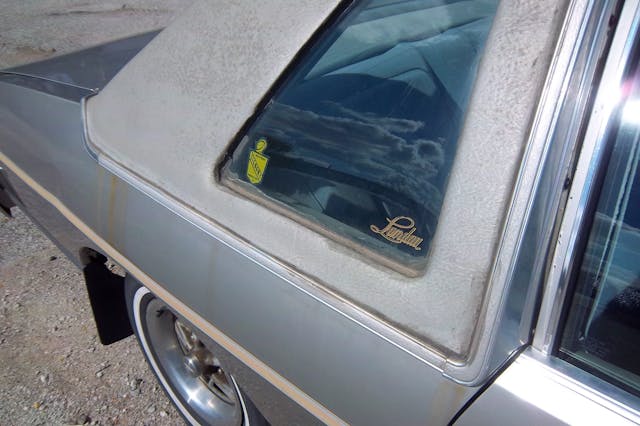
As expected, the Bonneville Brougham was the swankiest full-size Pontiac. Peppered with extra features inside and out, the biggest difference from the basic Bonneville was the interior. There was loose-cushion, velour seating with a 60/40 divided front seat, a fold-down center armrest, deep-pile carpeting, electric clock, custom chrome-trimmed pedals, and a ‘luxury’ cushioned steering wheel.
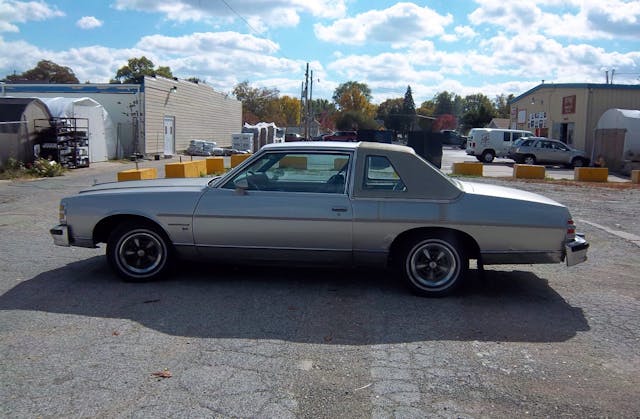
Yes, the Brougham was quite the cushy, well-equipped car, with poofy seats, extra sound insulation and a bright red arrowhead adorning its chromed nose, but it just didn’t sell like the Caprice. However, the 1977–79 Catalinas and Bonnevilles did sell significantly better than their 1976 predecessors.
Pontiac was quick to point that out in the 1978 sales brochure: “We called them ‘the right cars, at the right time.’ And we were right. Because America’s drivers purchased over 40 percent more 1977 full-size Pontiacs than they purchased 1976 full-size Pontiacs.”
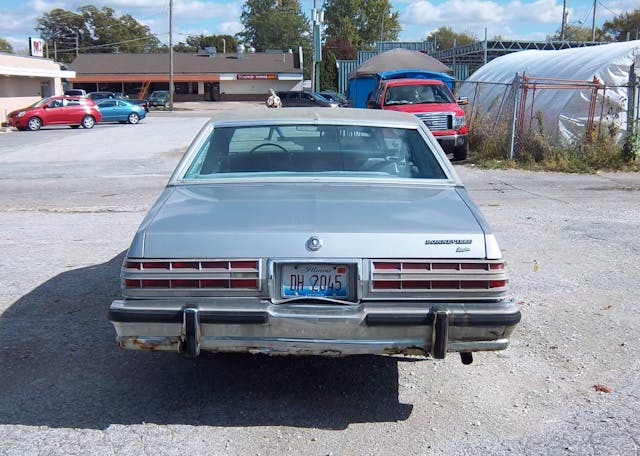
And the numbers only got better. In 1977, 114,880 Bonnevilles were sold; 125,297 moved in 1978; and 1979 sales totaled 162,491. Not bad, but still a blip on the radar compared with Caprice sales of 284,813, 263,909 and 261,470 for those same years. While that isn’t good news for folks seeking an affordable collectible, perhaps it still will work in the Bonneville’s favor as time goes by. The relative scarcity may one day enhance both its value and survival rate.
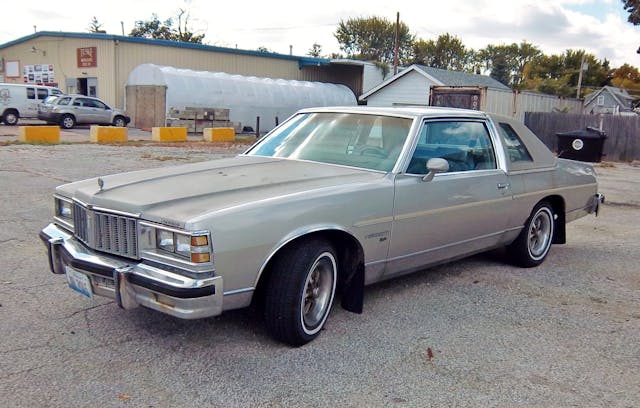
Yes, these cars are my favorites, but sadly they’re quite rare here in the Midwest. With that said, by dumb chance and with the help of Lady Luck, I quite happily found this silver ’79 Brougham coupe about 10 years ago. Geez, where has the time gone?
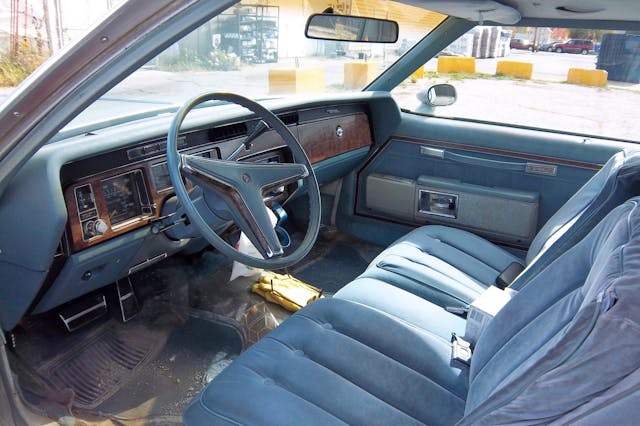
While on my way to 16th Street in Moline, Illinois, I took a side street I rarely used to avoid congestion at a red light. When I glanced over at a parking lot while passing through an intersection, I spotted this Bonneville. Holy cow, a Bonneville coupe! It was even a ’79, like Dad’s.
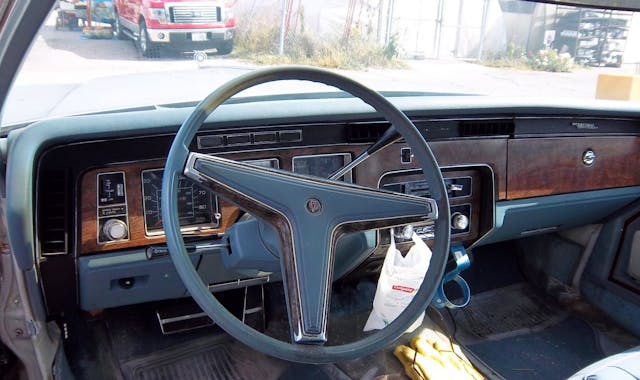
There was a fresh-vegetable stand across the alley, so I parked and walked over to see if one of the customers knew anything about it. Dan, the owner, turned out to be a very nice guy who was flattered that I was interested in his old car. I told him my dad had owned one, and I asked if I could take some pictures. He said no problem.
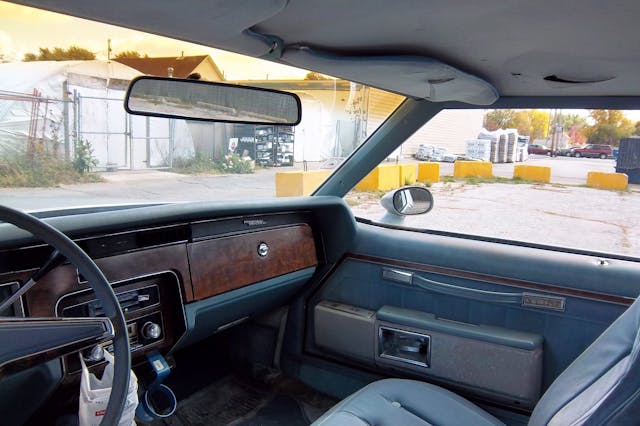
Dan is the one-and-only owner of this Brougham, which he purchased brand-new at the now defunct Horst-Zimmerman Pontiac-Cadillac in downtown Rock Island, Illinois, trading in a ’73 LeMans to get it. He told me he had also looked at Bonnevilles at Perry Snower Pontiac-Buick, in Moline, but since they wouldn’t deal, the silver coupe in Rock Island was the one he bought. What I find interesting is that Horst-Zimmerman was right across the street from Illinois Casualty Company, where my dad worked.
It’s fascinating that at the same time Dan was doing the deal on his silver Bonneville coupe, Dad was most likely about 50 feet away, sitting at his desk, with his brown Bonneville sedan in the nearby parking lot. And yes, the company bought their cars from that dealer because it was so convenient. Small world.

Dan’s Bonneville is equipped with multiple noptions, including power windows and door locks, the gauge package, padded Landau roof, sport mirrors, and the classic Pontiac Rally wheels. He said the car cost about $10,000 new and that they’ve been through a lot together since then.
Dan related an amusing story of a hit-and-run in which the driver of an early ’80s Town Car took off after crashing into his car. Fortunately for Dan, the genius behind the wheel left his license plate behind in the collision, so Dan simply took it to the police station when he made his report.
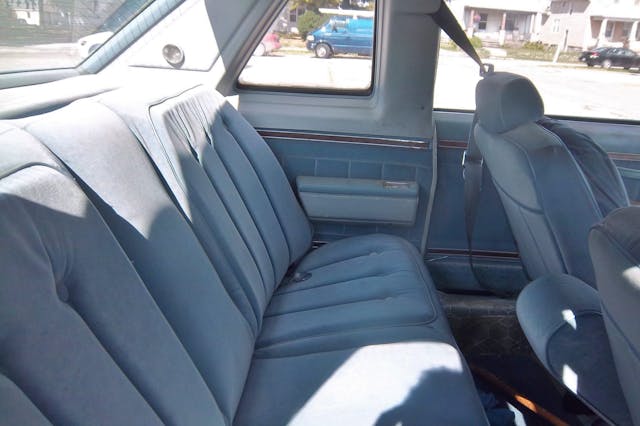
At the time, Dan’s Bonneville had just shy of 90,000 miles on the odometer. It wasn’t a show car, but it was still pretty decent for a late-1970s Detroit cruiser, daily driven in the salty Midwest. Dan still had the fender skirts, too. As you can see, the interior was still very presentable—and comfortable.

After I took way more photos than necessary, Dan and I parted ways. It was great to check out his car up close and chat with him about it. Over the past decade, I still occasionally see Dan and the Bonneville in traffic. It’s good to know that they’re still together.
